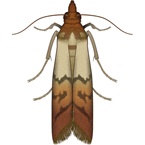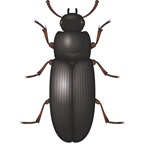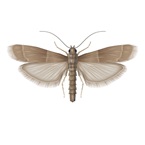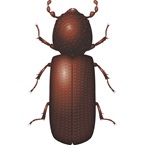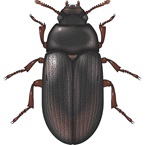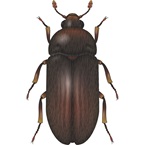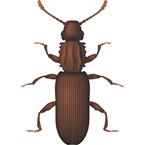Order: Coleoptera (‘sheath-wings’)
Family: Curculionidae.
Grain Weevils:
3.5mm long
CHARACTERISTICS:
Forewings hard and leathery, meeting along mid-line of dorsal surface; hindwings membranous, sometimes lacking; biting mouthparts; well developed thorax; complete metamorphosis with egg, larval, pupal and adult stages. Insects with cylindrical bodies and a pronounced rostrum (snout) equipped with mouthparts which is used by females as a boring tool; elbowed, clubbed antennae set on rostrum; 4-segmented tarsi.
SPECIES CHARACTERISTICS:
Grain Weevil (Granary Weevil) (Sitophilus granarius)
Adults, 3-4mm long; colour: dark brown, nearly black, with shiny appearance; 8-segmented antennae; prothorax with distinct oblong/oblongoval punctures; hindwings absent.
Rice Weevil (Sitophilus oryzae)
Adults, 2-3.5mm long (average 2.5mm); colour: dark brown, nearly black, with four clearly defined reddish spots on the elytra; less shiny than the Grain weevil; 8-segmented antennae; prothorax with round or irregular punctures; hindwings present.
Maize Weevil (Sitophilus zeamais)
Very similar in appearance to the Rice weevil with the characteristics described above, except that the insects are longer, adults reaching a length of 3-3.5mm (average 3mm).
AREAS WHERE FOUND:
Grain weevils are encountered in all temperate and warm-temperate climates and are widely distributed in grain stores throughout Europe. Infestations arise as a result of their regular importation in grain and cereal products and from the fabric of vehicles or buildings used for the transportation and storage of these and other vulnerable commodities. Sacks, too, are an important source of infestation, the insects finding harbourage in the seams and weave. Being well suited to temperate conditions the species will breed readily in South Africa and there may be three or more generations per year in unheated conditions. Both adults and larvae are coldhardy. Rice and Maize weevils are widely distributed in tropical and sub-tropical areas and will be carried to temperate areas on imported commodities. The Maize
weevil will breed on maize in the field, but the Rice weevil only breeds in stored grain. Both insects are less coldhardy than the Grain weevil and will not normally overwinter in unheated premises or grain stored at normal temperatures.
IMPORTANCE AS A PEST:
Grain weevils are important pests of farm-stored grain. They are frequently regarded as primary pests of grain since they are able to infest otherwise undamaged grain. Grain weevils will also attack other hard cereal products, e.g. macaroni and spaghetti. Fine cereal products are unsuitable for breeding purposes unless they become caked. The following damage may be caused:
- Reduction in the weight and quality of grain as a result of the larvae feeding on the endosperm. The germ is not always attacked so germination may take place, producing a weak seedling which is vulnerable to attack by moulds, bacteria and other insects. Both larvae and adults will feed upon grains.
- Tainting with white, dusty excreta which contaminate the product as well as rendering it unpalatable.
- Heating of the grain, accelerating development of the insects and making the commodity liable to caking, moulding and even germination. Temperatures may be attained which actually kill the insects.
LIFE-CYCLE:
The Grain weevil can only breed in grain with a moisture content of more than 9.5% and at temperatures within the range 13-35°C. The female lays about 200 eggs at a rate of 2-3 per day depending upon temperature and humidity, placing each one in a small hole bored in the grain and sealing it in with a mucilaginous plug of saliva. At 18-20°C the eggs hatch in 8-11 days to give small, white, legless larvae which feed on the endosperm of the grain. Only one larva develops in small grains such as wheat and rice but large grains such as maize will support the development of several. Larvae are never freeliving and develop entirely within the grain. They moult four times, finally pupating within the grain after 6-8 weeks. The adults emerge after a further 5-16 days and will live for about 9 months. If disturbed they will feign death by drawing their legs up to their bodies and remaining still. At 15°C and a grain moisture content of 11.3% the full life-cycle takes 6 months. The life-cycles of the Rice and Maize weevils follow a similar course to that of the Grain weevil.
CONTROL:
Assessment of infestations
A variety of trapping techniques are available for measuring stored product beetle infestations. These include pit fall traps, bait bags, insect probe traps and adhesive traps. Whatever system is employed adequate records must be kept.
- Hygiene/management
Stores should be soundly constructed to ensure maintenance of correct storage conditions and allow for easy cleaning. They should be insulated, well ventilated and damp-proof. Cracks and crevices, which may provide harbourages for the beetles, should be kept to a minimum. Commodities should be stacked neatly above the floor level using pallets, away from walls and should not touch the ceiling. A gap between stacks will allow for ventilation, regular inspection, cleaning and, if necessary, treatment with insecticides (see recommended products). Appropriate stock rotation is important and if possible there should be a one-way passage of commodities through the premises. The careful choice of packaging can help to deter insect attack. Generally, thick, tough materials with a smooth, shiny finish are preferred. Packs should be strong and well sealed. It is important to ensure that there are no food residues (stored commodities or secondary sources, e.g. birds’ nests) in which beetles can breed and develop to infest new materials. All infested commodities should be destroyed or fumigated. Stores should be kept scrupulously clean and farm stores should be thoroughly cleaned before harvest. All grain taken into store should be dried to a suitable moisture content (MC) and temperature e.g. <15%MC and <15°C and maintained in that condition.
- Insecticidal control:
Insecticides (see recommended products) can be applied to the fabric of stores concentrating on potential insect harbourages. Alternatively it may be appropriate to employ grain protectants.
GLOSSARY OF TERMS:
Elytra: Hardened forewings of the beetle, Prothorax: First thoracic segment.

